Burmese Days
Although most of us wouldn't admit it, not a lot of people know what Myanmar is. Is it a soup? Some rare type of flower? A new player for the local hockey team? Calling it "Burma" instead, eyes light up.
The Union of Myanmar—known as Burma up until 1989—is the relatively new name for a Texas-sized country strictly controlled by an oppressive military regime. Many governments and news agencies have rejected the new name and government, still referring to the country as Burma, like in the recent State of the Union Speech, where the country got a brief mention as President Bush called for freedom in Burma. George Orwell's early book Burmese Days, written after he was stationed in the country as a British officer, is considered by some Orwell fans as the first part in a trilogy he wrote about Burma. The other two are his most famous books, Animal Farm and 1984.
Going to Myanmar is a difficult ethical question, and was not an easy choice for us to make. Many international activist groups believe that by visiting Burma, travelers are effectively voicing support for the country's horrible regime. Much of the tourist (and other) infrastructure throughout the country has been built by forced labor, and pumping in more money to the government could be directly going toward furthering human slavery. Tony Blair has asked British citizens to boycott tourism to the country, as has Nobel Peace Prize-winning Aung San Suu Kyi, the democratically elected (and subsequently jailed) leader of Burma. On the other hand, condemning the people of Myanmar to cultural isolation from the rest of the world doesn't seem like an appropriate solution either. The Burmese people are without a voice on the international stage, and one of the only connections they have with the outside world is through contact with international travelers. The issue is way too complicated to discuss at length here, so visit Voices for Burma for an excellent rundown of the pros and cons of visiting Burma. The site ultimately recommends what they call "small-scale, ethical tourism," which essentially boils down to traveling independently and reducing government spending as much as possible, which is what we decided to do.
Our flight from Bangkok to Yangon left early in the morning, so Gerni and I caught the last shuttle of the evening and set up camp in the Bangkok airport for the night to save a few bucks on a hotel room. Lasting just over an hour, our flight to Yangon—the capital city formerly known as Rangoon—was short, and before we knew it, we were through customs and whisked off to our cave-like hotel room. The few days prior had been an exhausting mess of running errands, hospital visits, and tying up loose ends, so Gerni and I took it easy for a day of sleep and casual wandering. But first, we had to get some money.
There are no ATMs in Myanmar and credit cards or travelers checks are all but useless, so the only way to get money in Myanmar is to bring all your money into the country in US Dollars. Changing money through government sources gives horrendous exchange rates, so everyone changes their money through the black market, which most guesthouses will do without hassle. The largest bill in Myanmar—1000 Kyat—is worth about 80 cents, so exchanging fifty bucks leaves you with massive stacks of cash.
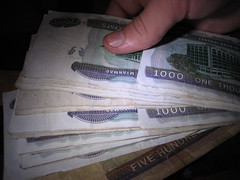
Downtown Yangon reminded me a bit of the parts I liked about India — chaotic, bustling, and fun. Part of me was expecting to be transported into the pages of 1984, with brainwashed drones quietly moving about their daily lives. Instead, we found people out chatting at Myanmar's ubiquitous tea shops, hundreds of monks running daily errands, and people surprisingly trying to discuss the grim political situation with us, mostly in nervously hushed tones. Yangon's streets are strewn with a moving mass of people, trishaws, and impressively crowded pickups with people pouring out from all sides. Storefronts along the street were an equally interesting visual feast.
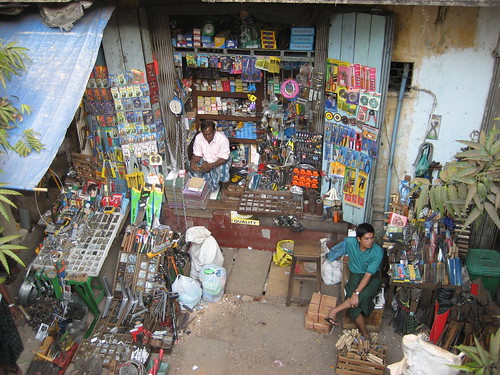
Before we left the city, we spent a day at Yangon's biggest attraction, and the country's most loved cultural site: Shwedagon Paya. Like the Golden Temple back in India, I immediately was captivated by the amazing place. Much more than just a single temple, Shwedagon is like Buddhist Disneyland, with about a hundred temples all competing for space around a beautiful circular courtyard. Gerni and I made the barefoot walk around the circuit several times, soaking in the atmosphere as the sun went down and the lights turned on. For good luck, we joined the locals and each added 24 cups of water (the number of our next age) over the shrine for the day of the week we were born. Born on a Wednesday, I had a trouble locating mine because in Myanmar there are officially eight days a week — strangely enough, Wednesday morning and Wednesday evening are considered to be two different days. Here's a photo of the paya followed by a video of the endlessly atmospheric courtyard:
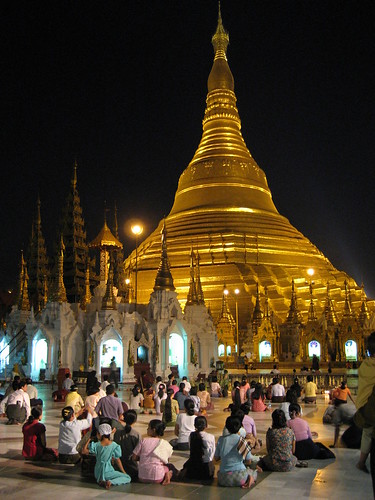
The next morning, we boarded the first of many rickety buses we would ride in Myanmar, this time headed to Kyaiktiyo, home of the Golden Rock — one of the most important Buddhist pilgrimage sites in the country. We settled in at our cheap hotel, which set us back three dollars each for a clean room with attached bathroom and shower including breakfast, the standard (and absurdly cheap) cost for a room in Myanmar. From our place in the town of Kinpun, the only way to get to the Golden Rock, apart from braving the six-hour hike up the mountain, was to jump on the back of a packed local pilgrimage truck. We squeezed into the truck and sped along the bumpy dirt roads, causing everyone inside to bounce around like pilgrim popcorn. It made for a really fun trip though:
-- video coming soon --
After safely dismounting the truck, we made the final hour-long climb by foot along with everyone else. Well, mostly everyone else: if you get a thrill watching people suffer, you can rent four dudes to carry you to the top in a sedan chair. Despite the Golden Rock's importance to Myanmar's many Buddhists, I wasn't really pumped up to see it for some reason. How cool could a rock possibly be, right? As it turns out, really cool. Gerni and I did the pilgrim thing by adding gold leaf to the rock, and hanging bronze bells along the railing by the rock which joined the others to pleasantly clang in the wind. We spent most of the day there in the relaxed atmosphere, which made for great people-watching as the rock lit up under the light of the setting sun.
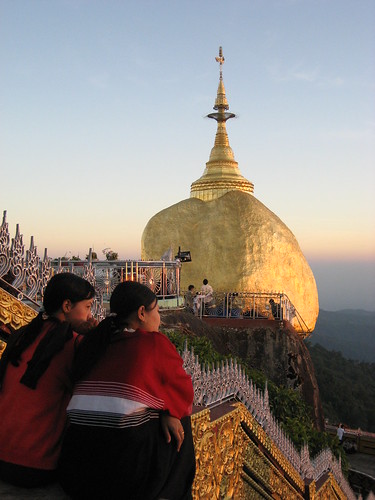
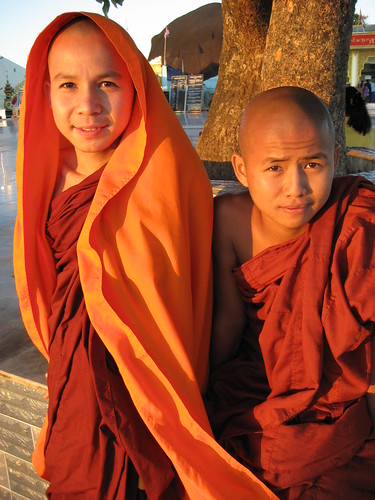
The next day, we boarded a bus for a quick day trip to Bago, a nearby town which seems to get a strange thrill out of trying to build the biggest possible Buddha statues. Unfortunately, most of the sights in Bago are government run, and charge a hefty 10 dollar entrance fee. Luckily, we were approached by some motorbike drivers who offered to take us to all of the town's major sights without paying the government fee. We climbed aboard the motorbikes and sped from sight to sight, avoiding government spending by going into back-door entrances or lingering just outside of ticketable areas. At one of the Bago's many enormous reclining Buddha statues, our guides brought us all the way to the ticket booth, where we were able to see the entire thing for a few minutes before getting asked to leave by the disgruntled ticket saleswoman. We saw several more reclining buddhas, Bago's impressive city paya, and even made a strange stop for a photo-op with a monstrous boa constrictor. Gerni declined to partake in the snake holding, but I held it around my neck like it was a... uhh.. boa. Later, we stopped in a large monastery where we arrived in perfect time to volunteer to dish up rice into the monk's plates before their 11 o'clock lunch:
After our short tour of Bago, we got on a seriously long night bus to the mountain town of Kalaw. The most frustrating part about travel in Myanmar is how absurdly long it takes to get anywhere. The distance from Bago to Kalaw is about the same as Denver to Cheyenne, which takes just shy of two hours on the interstate. In Myanmar, the same distance takes 15 hours. 15 hours!!! The country's national highways are mostly cruddy, one-lane dirt roads, which are full of broken-down buses, horse carts, people on bicycles, kids playing soccer, and slow smokey tractors carrying what seems like hundreds of people. The only other westerner on the bus was Michael, a really great Swedish guy on holiday from Sony Ericsson, who we befriended and ended up traveling with for the next three weeks.
At around 4 am, the bus stopped in Kalaw and we jumped out into the freezing air. My body was in shock because it was so cold — I've completely avoided winter since I left Colorado, and this was my first taste of it in almost a year. We found a hotel with big blankets and tried to stayed warm until the morning. Kalaw is a really pretty small town, but our real reason for stopping here was to go trekking. We researched a few options, and decided upon a three day trek to Inle Lake, where we were heading anyway. After a night eating delicious Nepalese and Tibetan food at one of Kalaw's restaurants, we were ready to start trekking in the morning.
We set off early with our fearless guide Jimmy, who led us for an amazingly cheap rate of $10 per day each including meals and lodging. We wandered through the tea plantations of Kalaw's countryside, had some nice pumpkin curry for lunch, and passed through several villages populated by curious ethnic minority people who were quick to offer us tea. Jimmy spoke the basics of several of the area's minority languages, so we were able to communicate with the people a little bit and find out more about their lives. We ended the night in Ywar Bu village, where we stopped for the night for dinner and sleep in a villager's home. The freezing cold, minimal blankets, and hard wooden floor made for a truly rough night's sleep — even on sleeping pills, I barely got a wink.
Our second day of trekking was spent traversing across gently rolling hills, covered in patchwork farms growing mostly chili, ginger, and tea. We passed through several villages, and stopped in for a quick stop at a rundown one-room schoolhouse, where the scruffy village kids went completely bananas for our entire half-hour visit. I made a failed effort to try to help the kids learn a few words in English — they liked screaming and jumping much better. Gerni made the mistake of trying to pass out candy to a few of the school kids, which caused their fellow classmates to attack him like a pack of cute little wolves:
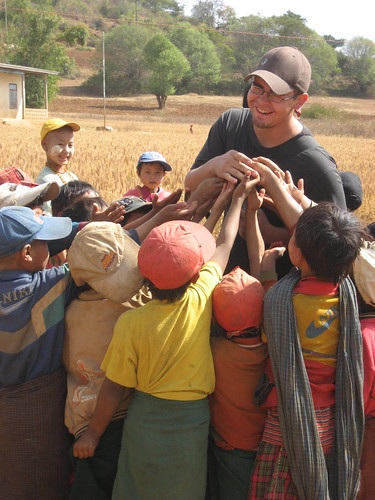
We arrived in Hti Tain village at the day's end, where Jimmy led the three of us to our humble beds inside the town monastery. After two tough days of hiking and freezing our asses off in the villager's home the night before, we were delighted to find a tiny supplies shop in a corner of the town school teacher's house, stocked with a few snack options and bottled water. She also had beer! And cigars! I suppose it goes without saying what happened next:
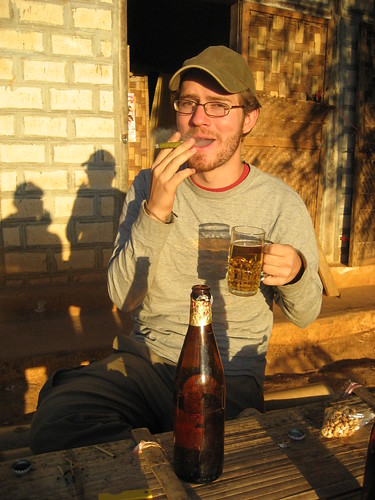
We awoke the next morning early. Too early. At about 5 am, the devoted monks started chanting and didn't stop until sleep was only a distant memory. Despite the short night, we all loved listening to the chanting from the warmth of our thick blankets. We caught breakfast and headed back out onto the trail, weaving along past dusty farm roads past ox-driven carts, more excited kids, and farmers peppered throughout the rolling fields. We ended the trek in Indein village at the southern tip of Inle Lake, where we caught a longboat to the opposite side of the enormous lake where Michael, Gerni and I checked into a cheap hotel and parted ways with our guide Jimmy and our cook Mr. Beard.
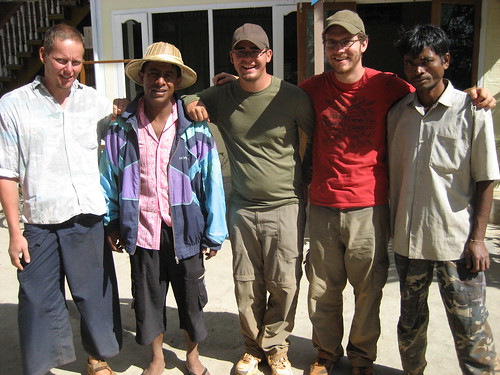
Inle Lake is probably the most popular area for tourists in Myanmar, and for good reason. The sprawling lake and surrounding marshes are home to thousands of handmade thatched-roof huts built on stilts, which appear to float on the surface of the lake itself. I was quite surprised when we got to Inle how many luxury hotels have sprouted up along the lake's shores, mostly catering to 60-something French and Japanese couples on expensive (and often government-run) package tours. As we started to explore the lake, I was fascinated by the way the fishermen row their boats with one leg when they get tired:
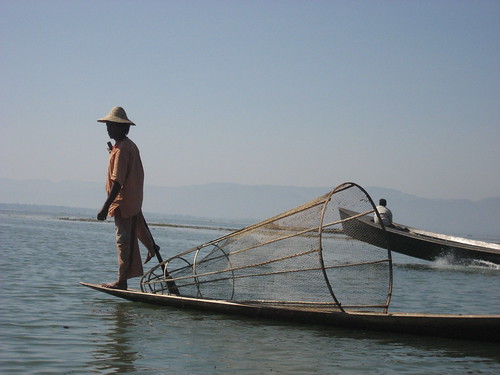
We spent a day riding dangerously rickety bikes around the gorgeous shores of Inle, exploring the fascinating floating villages along the way. We also spent a day speeding around on a longboat, visiting a few tiny tourist-oriented factories along the way where we got to watch people weave silk, make paper, and craft raw silver into jewelry. We paid a quick visit to a quirky monastery where the bored monks taught cats to jump through hoops, which was as strange as it sounds. Another stop took us to a store run by a family of long-neck villagers, the vast majority whom live in other parts of Myanmar and Thailand restricted to tourists. It was interesting to see them in person, but I'm glad most of the long-neck villagers live in restricted areas to shelter the people from the obvious tourist draw of their unique and painful-looking tradition.
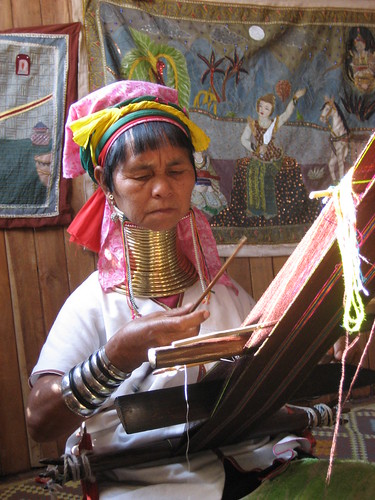
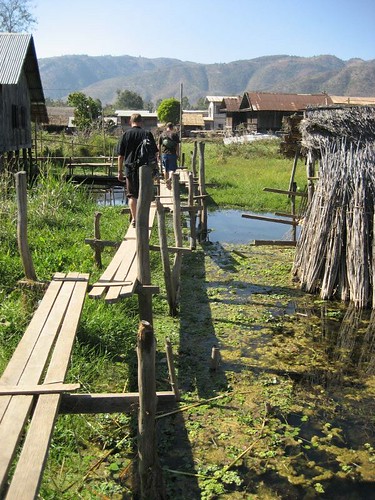
We left Inle Lake headed toward Mandalay on another typically long and painful overnight bus, this time with enormous bags of rice filling our legroom space. We arrived in Mandalay before dawn and scouted out the city's grim accommodation scene. The best room we could find looked like Gallagher had just checked out—stray hairs everywhere and a smashed watermelon on the floor—so the three of us made the quick decision to go somewhere else. Like, to a different city. We hopped aboard a shared pickup headed for Pyin U Lwin, about a two hour drive to the north. And just when I thought the pickup was full, it got fuller. And fuller. And fuller. And fuller. And fuller. In the end, there were 29 people inside a tiny Toyota pickup, plus around 10 more people up on the roof above the seating area. It was insane. I've been inside some impressively-packed vehicles in Asia, but this was a new extreme.
Pyin U Lwin was a really cool little town and the streets were scattered with some gorgeous architectural leftovers of the town's days as a British retreat from the sweltering heat of Mandalay. We spent two days soaking in the atmosphere, checking out the old 20s-era mansion-like hotels, and shopping for bargains in the city's phenomenal antique stores. The highlight was definitely our awesome ride to dinner one of the city's ubiquitous horse-drawn stage coaches, which make the town look like the movie set of an old Western.

Our next stop was the nearby town of Hsipaw a few hours further north. We stayed at Mr. Charles Guesthouse, which is the lively epicenter of the Hsipaw backpacker scene. Like Tibet earlier on the trip, not too many people visit Myanmar, so you end up seeing a lot of the same 20 people from place to place, which in Myanmar is a really good thing. The country's current off-the-beaten-path status has made it a haven for older, more experienced, and generally more intelligent travelers, rather than the party-till-you-puke crowd spread throughout Thailand.
Hsipaw was a pretty interesting town with lots of typically Burmese tea shops, dusty streets, and colorful outdoor markets. Our main reason for going there was to use it as a jumping-off point in our attempt to get to the very rarely-visited town of Namshan, a six hour drive north to do more trekking. We had dinner one night with a guy who had just completed the trek from Namshan back to Hsipaw, and he passed along the only "map" of the area that is available — a piece of paper with four towns written on it in Burmese script, plus a longer note in Burmese that says "Please help these foreigners find their way to Hsipaw."
Excited to have something to guide us for the trip back to Hsipaw, our next concern was to figure out how to get to Namshan. We asked around town, and nobody seemed to have any reliable information about how to get up there. Taxi drivers all said the road was too bad to drive on, and nobody was sure when the next cargo run was leaving town. After two frustrating days in Hsipaw struggling to figure out how to get up to Namshan, it became clear that the only sure-fire way to get there is to hitchhike. And hitchhike we did.
Gerni and I set out on foot, still accompanied by our Swedish friend Michael, and now with two new companions: Vincent and Isabelle, a delightful couple from France who we met a week earlier. The five of us walked for an hour along the road to Namshan and our prospects looked grim — not a single vehicle had passed us. Suddenly, a big cargo truck plowed by, so we flagged it down. The Chinese driver was ridiculously friendly, spoke a few words of English, and seemed delighted that we wanted to ride in the back of his truck. And better yet, he was going all the way to Namshan. We threw our backpacks in, and jumped aboard. We bumped along for two hours up curves and switchbacks along the worst road in history before the driver stopped to fill up the truck with more cargo. We held on tight as we laid down for the last four hours, crammed in the narrow space between enormous bags of tea and the ceiling of the truck, while we watched the misty mountain scenery zoom past.
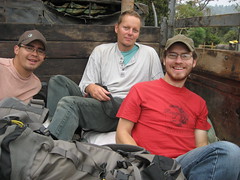

At dusk, we finally arrived in Namshan, a small village in the foothills of the Himalayas. The tiny town surprisingly had a modest family-owned guesthouse, which had a friendly staff and a handful of blanketed beds on the floor for visitors. We explored town for a little while, looking out of place like a small white-skinned street gang, and got some very confused looks by the locals. We befriended the town drunk, then headed back to the guesthouse to warm our hands by the fire and settle in for a nice dinner before bed.
We hit the trail the following morning, our "map" in hand, headed for the first village on the list. When we crossed paths with people along the way, we pointed at the name in Burmese and they pointed the direction we should walk, guiding us from place to place. It was clear immediately that this trek was really special — the area has only been open to foreigners for six months, so we were likely some of the first foreigners the people had ever seen. As we passed by the teakwood village huts, people seemed fascinated by our presence, and loved looking at their photos magically appear on the screens of our digital cameras. One of my favorite moments was watching this elderly woman crack up when she saw her photo on Michael's camera:
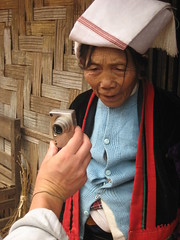
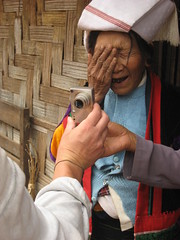
In some villages, we were watched with curious stares out of windows or greeted with hearty waves, but one village took the cake the warmest welcome of the trek. As we arrived, word spread like wildfire that foreigners were in town, and we attracted an enormous crowd at a house where we were invited in for tea. About a hundred people of all ages—the majority of the village—watched us as we smoked cigars with the men and drank tea with the ladies as open fires burned in the house to keep everyone warm. One or two of the villagers spoke basic English, so we were able to communicate with the people about our families, our countries, and more. It's hard to do the experience justice in words, but was one of the truly special moments of the trip, and I'll remember it for the rest of my life.
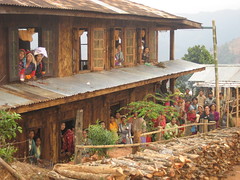
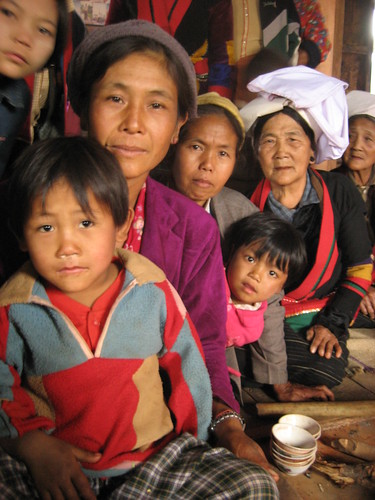
The end of the first day, we ended up in Quan-Hai village, where the five of us showed up at the town monastery hoping they would allow us to stay there. The head monk was happy to have us, and helped us gather blankets and offered us a patch of space on the floor where we could sleep. We found a humble restaurant using our best spoon-in-mouth hand gestures, and attracted another big audience who curiously watched us play some post-dinner gin rummy.
The following day was a literally a long uphill climb, passing through more gorgeous villages filled with more cute kids. We ended the tough day early in Ko Ha, where we again tried our luck at the village monastery. After some awkward moments with the language barrier, they finally understood that we needed a place to stay, and agreed to let us camp out on the floor. Although it was in the middle of nowhere, the village somehow had electricity and we sat horrified as the young monks and their friends watched the finest of American television: a WWF wrestling match. We ate Chinese-style steamed buns at nearby family's home, who took us in as if we were long-lost relatives. Here's a shot of the family, the monastery, and some of the monks:
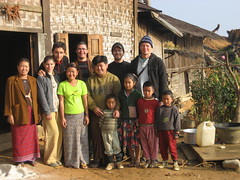
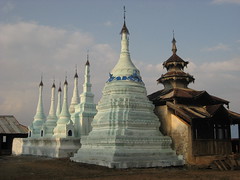
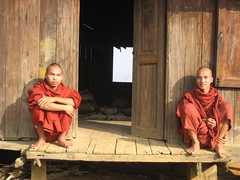
We were pretty exhausted by our third day of trekking, put we kept pressing on toward Hsipaw. We cheated a bit and caught a short ride on the back of a passing truck, and then cheated again doing the last few miles bouncing along as we hung on for dear life onto the sides of a speeding tractor. We arrived back at Mr. Charles, where Vincent, Isabelle, Michael, Gerni and I had a nice celebratory dinner at the nearby restaurant called Mr. Food (continuing the trend, the bookstore in Hsipaw is named Mr. Book).
The following morning, we were on the bus back to Mandalay for a little while, where we did our best to get online to bump our flight back a few days in order to give us more time in Myanmar. Internet access in Myanmar is brutally slow, expensive, and in the rare moment where you do get online, almost everything you want to visit is banned — Gmail, Hotmail, and Yahoo, Wikipedia, Blogger and the BBC included. We fought with the internet for a few hours before giving up, which meant that we'd have to cut our time in Mandalay short and get on the bus to Bagan, Myanmar's archeological wonderland, eight hours away.
But first, we stopped to see Myanmar's most famous political-satire comedy troupe, The Moustache Brothers. One of the brothers, Par Par Lay, spent seven years in a Burmese prison for telling jokes about the government, which was briefly mentioned in a scene in the movie About A Boy. He's now out of jail thanks in part to Amnesty International, and the group puts on a dance and comedy routine every night in English for tourists, who actually play a role in keeping them from being arrested again. With a steady flow of tourists pouring in each night, the government has no choice but to allow the show to go on, turning a blind eye to their anti-government commentary. Here are the guys at the end of the goofy show:
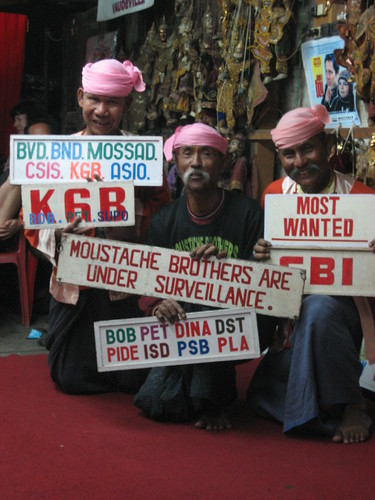
After a long bus ride the next morning, and with a looming deadline of a flight leaving from Yangon two days later, we hit the sights in Bagan immediately. We hired a horse cart and driver for the day for about seven dollars, and made our way around the unbelievable temples of Bagan. Like Angkor Wat in Cambodia we saw a month prior, Bagan is one of the best archeological sites on earth. An estimated 4000 temples (!) sit scattered on a wide plain stretching out into the distance, each with its own character and personality. I couldn't get enough of the amazing plaster carvings, the unique brickwork, and interior fresco paintings of each temple. And unlike the temples of Angkor, Bagan has relatively few tourists, which makes it easy to get away from the crowds and explore temples on your own.
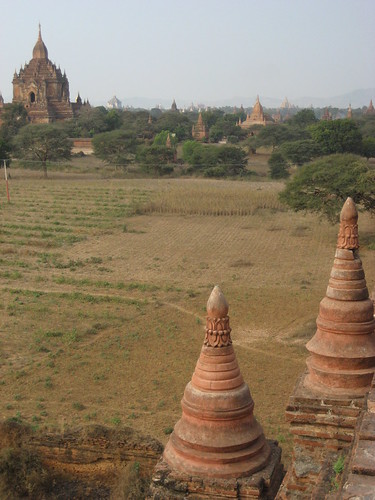
Our second day, I rented a bike from our guesthouse that looked like a 1930's movie prop, and did a day exploring lesser-known temples, which I liked even better than the handful of popular ones. The sheer number of temples is completely ridiculous, and temples that would be a major cultural heritage site in any other city on earth are downright forgotten at Bagan. At one very forgotten temple, I found an elderly monk who had taken up residence inside the temple's 1000-year-old walls. He was surprised to see me in his home, but offered me tea and a banana as we did our best to communicate in hand gestures.
Unfortunately, we had to leave Bagan at dusk and get on a night bus to back to Yangon in order to catch our flight. Still in Bagan 12 hours before our flight left, we took a serious gamble on the bus, which reportedly took somewhere between 10 and 18 hours depending on how many times it broke down. Cutting it absurdly close gave us a second day in Bagan, so we decided to risk it. As the bus plowed across central Myanmar, we urged the driver to get there as fast as possible and even offered him money if he'd get us there in time to check in for our flight. I was a nervous wreck the entire bus-ride, checking my watch every five minutes and reporting back to Gerni — "we're not going to make it." At 6:00 am, we got to a huge city and much to our relief, it was Yangon. We quickly piled into a cab and told the driver to haul ass to the airport. He pulled over halfway there for a leisurely stop to get himself some betel nut (like chewing tobacco, but much more disgusting) and we both almost killed the guy. Go! Go! Go! Don't stop, man! Go! Go! Airport! Airport! Amazingly enough, we got to the airport in time and checked in ahead of schedule. Or flight left an hour later and we high-fived the successful journey as we made it back to the bustling commercialism of Bangkok.
After 24 days in Myanmar, we were able to get a glimpse of a country sheltered from the rest of the earth by means of propaganda and strict government control. I'm not sure what will happen in Burma in the coming years, or whether the people will ever be free. The places we saw, the crazy trips on a plethora of vehicles, and the experiences we had made it one of my favorite places either of us have ever been. But the thing we enjoyed most was the people. Since they see relatively few tourists, Burmese people are incredibly friendly, curious, and welcoming to travelers. Out of all the places I've been, the people in Burma are the nicest and most enjoyable yet. Here are some of my favorite people shots from our Burmese days:

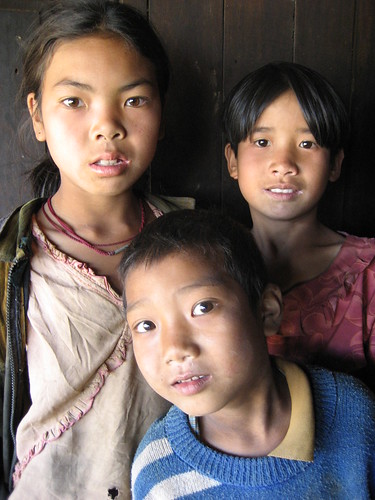
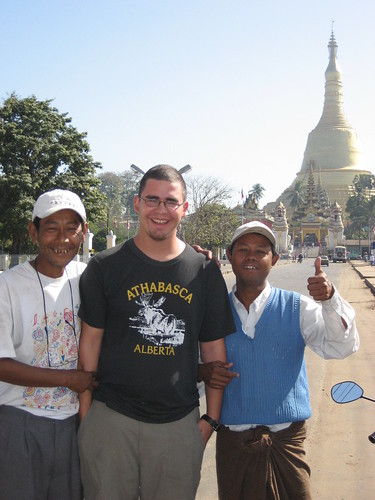
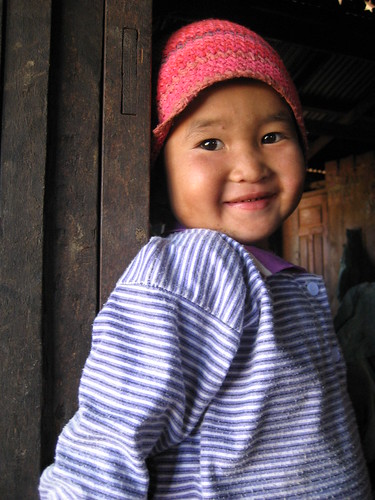

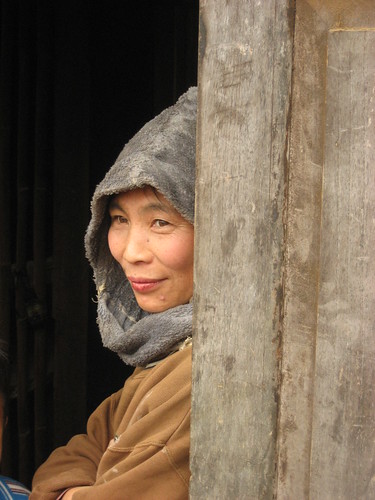
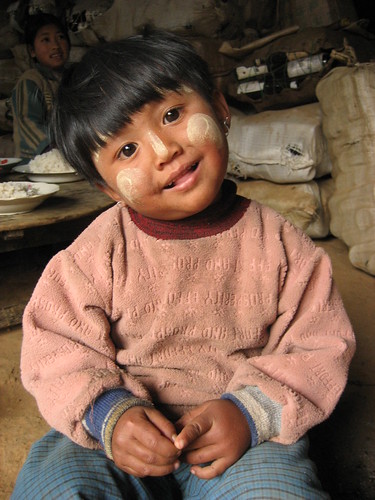
I in Bangkok now, where I've been relaxing for the last week. Gerni and I sadly parted ways two days ago — he's off exploring Thailand for a few days before he heads back to Denver with stops in Macau, Hong Kong, and Los Angeles along the way. Tonight, I'll continue on the lonely road as a solo traveler on a train to Laos, cut through Northern Vietnam, then complete my massive loop of Asia back in Shanghai, where I started this whole thing eight months earlier. I'm meeting my parents for my birthday celebration in Berlin on April 27th, so join me here for the next two months as I leave Asia and attempt to go from Bangkok to Berlin overland.
Thanks for reading this epic post! I miss you all.
Ryan!
Photos updated: All of Myanmar. Check 'em out! I'm having some issues with one of my memory card, so I'm missing a few pictures from Bagan (and a bunch of videos), but otherwise they're all there.